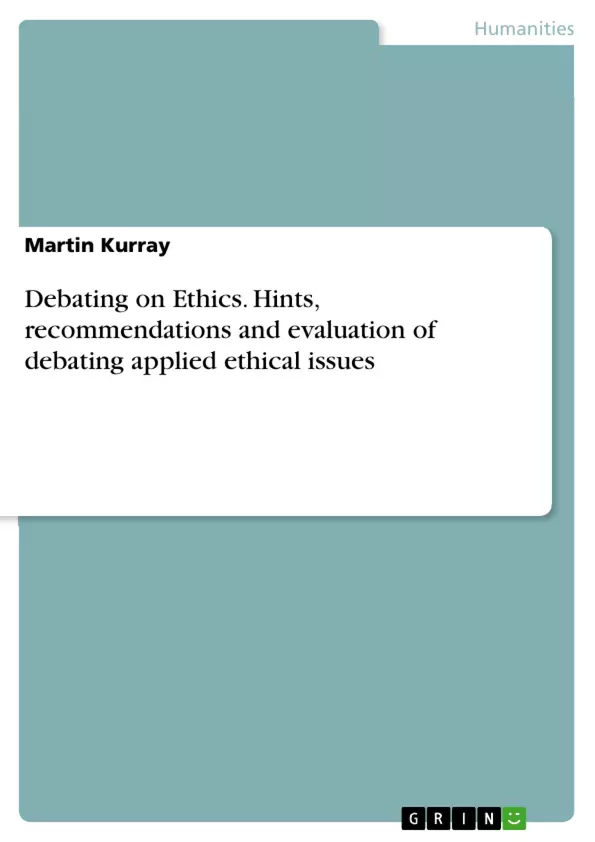The purpose of this script is to give recommendations, hints and tips for debating applied ethical issues, a highly interesting field in debating. It gives an introduction into ethics and the main theoretical approaches concerning moral philosophy. Beginning from the preparation and organization of a debate to the actual debating and performance of team and individual speakers the procedure and functions of debates are examined. Specific interest is given to rebuttals, points of interests as well as (logical) fallacies of argumentation that may occur during a speech and requires qualities in language and rhetorical skills in general. Individual speaker performance is considered by matter (content), method (strategy) and manner (style). For these areas of debating the paper gives recommendations and provides useful phrases to the student.
Ethics also plays part in all exchanges of opinions, The ethics of debate gives further insight into rules how to behave in a debate and how fruitful debating should be.
The second part considers the evaluation of debates. Usually the performance of teams are assessed and one team may provide better arguments and pursue a better strategy than the other party. General recommendations for adjudicators shall alleviate the process of judgment during the debating process as well as afterwards when the performance of parties is reviewed. The script proposes a possible evaluation scheme and a marking system that considers the individual performance but also recognizes the team strategy when debating applied ethical issues.
Finally a concluding section will summarize the main topics of the script by providing some examples of applied ethical issues.
Table of Contents
- Introduction: The Art of Debating ...
- Ethics.......
- Debating moral issues
- Debating on Ethics....
- Ethics of Debate..\li>
- Evaluation of debates
- Conclusion: Applied ethical issues....
Objectives and Key Themes
This paper aims to provide students with recommendations, hints, and useful phrases for debating, particularly moral issues. It also proposes an evaluation scheme to assist judges in assessing arguments and overall debate quality. The main objectives are to enhance debating skills, particularly in the context of moral issues, and to provide a framework for evaluating debates.
- Ethical principles and frameworks in moral philosophy
- Strategies and techniques for effective debating
- Analyzing and evaluating arguments in a debate
- The role of rhetoric and language skills in debating
- Developing a comprehensive evaluation scheme for debates
Chapter Summaries
The introduction delves into the history and significance of debating, emphasizing its connection to rhetoric and the concept of a debate as an interaction between parties with opposing viewpoints. It also highlights the special nature of debates on moral issues, emphasizing their inherent complexity and the importance of careful argumentation.
Chapter two introduces the core concepts of ethics, drawing on the works of Thiroux and Pojman to differentiate between ethics and morality. It highlights the interconnectedness of ethics, epistemology, and metaphysics, emphasizing the role of ethics in guiding human conduct and values.
Chapter three focuses on practical advice for debating on ethical issues. It provides useful phrases, recommendations, and insights into the ethics of debate, emphasizing the importance of respectful conduct and fruitful dialogue.
Keywords
This paper focuses on the key concepts of ethics, moral philosophy, debating, rhetoric, argumentation, evaluation, and applied ethical issues. It explores the relationship between ethics and other normative subjects like religion and law. Additionally, it delves into the practical aspects of debating, including strategies, techniques, and evaluation methods.
- Citation du texte
- Martin Kurray (Auteur), 2011, Debating on Ethics. Hints, recommendations and evaluation of debating applied ethical issues, Munich, GRIN Verlag, https://www.grin.com/document/341391



